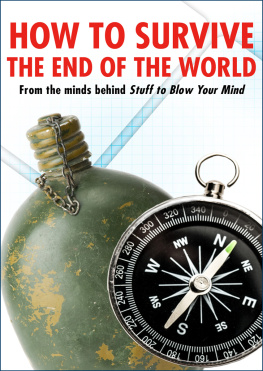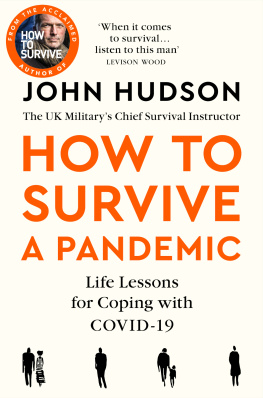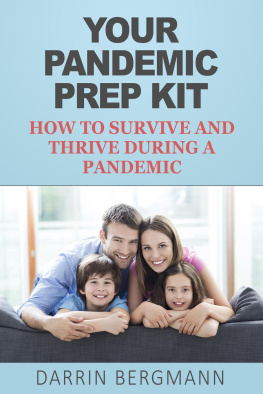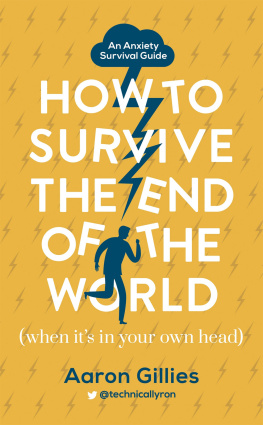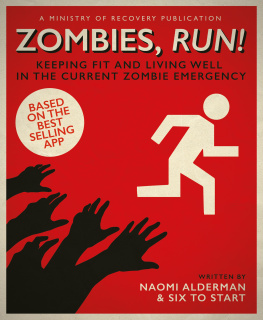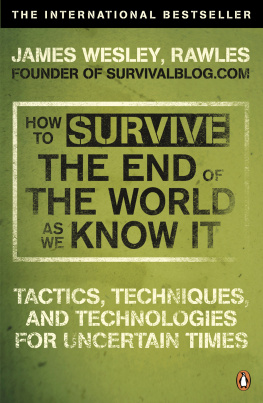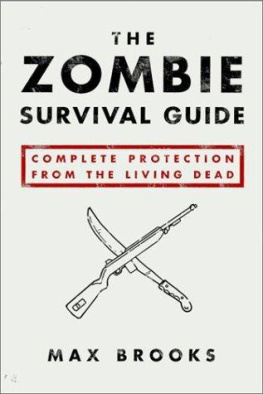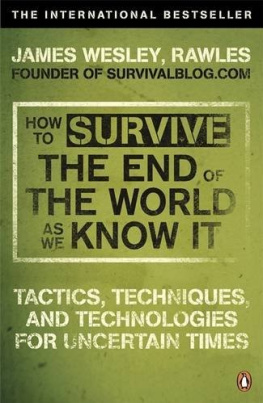HOW TO SURVIVE THE END OF THE WORLD

INTRODUCTION
If the world as we knew it came to an end, wed like to think wed survive. At least, wed like to think that compiling all the information in this book gives our readers an advantage.
If the zombie hordes are amassing and threatening to eat your brains; if a viral pandemic has rid the world of all its human hosts but for a hearty, immune few; if a massive, catastrophic coronal mass ejection sent a sun storm to render all electronics inert, this volume tells you what to do next.
Whether you are in a Midwest suburban home or an East Coast urban loft, if it is clear that you wont survive hanging around the dead, the near-dead, or the undead, you will want to head for the hills. Perhaps you are being chased and leave with nothing but a machete and your will to live. Perhaps you actually have time to pack, but you arent sure what you might need. Keep reading for advice on how to proceed.
Learn how to make shelter with your bare hands when night is falling and the storm is near. Learn which berries to look for in summer and why it is critical to cook the meat when you catch prey whether its a wee rabbit or a noble elk. Learn how to avoid succumbing to the terrifying physical stresses of being on the run from the dissolution of civilization including hypothermia, heatstroke, and starvation. This book will help, while also telling you what dehydration looks like and why you should avoid it.
And, once the dust settles and you are considering where youll build a farm to live out your remaining days in the Kingdom of You, we have two critical tips for you that will change the rest of your future, even the future of humanity: Head to Norway and raise sheep.
WATER
So, the future is yours. Well, yours and your hardy band of survivors. What do you need to worry about first? Water. It is the single most important thing you need to live.
When youre wading in a cool mountain stream, and you can see your toes in the sand, you assume the water is safe to drink. But even water that looks perfectly clear may harbor a variety of bacteria, parasites, and protozoa that can make you very ill. You cant tell from smelling or taking a small taste whether water is safe to drink. Even water from spigots in campgrounds may not be, and if you are in a campground, you should treat the water unless theres a sign specifically saying the water is safe.
Portable water filters are probably the easiest and safest way to treat water for drinking, so it is your first item to stock up on before the apocalypse. There are many choices in water filters. The least expensive may cost less than $20, while more expensive filters can cost several hundred. For the average user, its possible to find a perfectly functional water filter for less than $100.
You should expect water from different areas to have its own unique flavor, but the process of filtering the water doesnt make it taste funny. Water filters work by capturing the microscopic life that lives in abundance in freshwater.
The consequences of drinking untreated water can be severe. Water that tastes fine can contain bacteria, parasites, and protozoa that cause nausea, diarrhea, loss of appetite, fatigue, and vomiting. Some of the diseases spread through a contaminated water supply are botulism, cholera, and dysentery. Parasitic infestations from contaminated water can lead to the development of rashes, muscle aches, fever, chills, coughs, neurological symptoms, jaundice, and malnutrition. While most illnesses from drinking contaminated water cause discomfort for a few days or weeks, others can be deadly.
WATER FILTER BASICS
The communities of bugs that live in freshwater supplies include giardiasis and cryptosporidium. The purpose of the water filter is not to kill the creatures, but to capture them inside the filter and prevent you from ingesting them. The effectiveness of the water filter is determined by what is known as the pore-size efficiency. This is the measurement of the size of the openings in the water filter. These measurements are microscopic.
The measurement used to describe the size of the filters openings is called a micron. One micron is 1/1,000 of a millimeter. Any water filter with a micron size of one or less will remove parasitic eggs and larvae from the water as well as protozoa. To remove bacteria, the micron size must be less than 0.4 microns.
Regardless of the type of water filter, they all work in the same basic way. An intake hose is used to draw water into the filter. If you have a filter inside your water bottle, youll fill the water bottle up first and place the filter inside. If you have a standalone filter, you can scoop water into a pail or put the intake hose directly into the water source.
Once inside the intake hose, the water is pressed through the filter, either manually, for a freestanding filter, or through suction, with a water bottle filter. The filter traps any microorganisms that may be living in the waterand, like we said, it doesnt kill them. Once the debris is captured in the filter, clean water passes through and is ready for drinking. The area where the clean water exits the filter is called the filter outlet.
CHOOSING A WATER FILTER
The style of water filter that you choose depends on your personal needs. Many people favor water bottles with the filter built in. Others choose a small hand filter that allows them to purify water as they pull it from the water source and dispense it into separate containers. If you have a water pack system that fits into your backpack, its possible to purchase a water filter system that coordinates with it.
How you decide what water filtering system will work best for your needs depends on a variety of factors. If you travel with youngsters and plan on filtering their water, youll probably want a separate hand filter. Many survivors like to add powdered drink mixes to their water. If youre one of these types, you probably dont want a water bottle filter. This way you can have separate drinking containers, one with your drink mix and the other with plain water. If you add drink mix to a water bottle filter, you wont be able to drink or filter any water until the bottle is empty.
If youre hiding out in wilderness in most parts of the world, a water filter that filters for bacteria, protozoa, and parasites should be more than adequate. If youre headed for a Third World country or an area where the water may be exposed to sewage, your filter also needs to kill viruses.
Water filters that are equipped to kill viruses most often contain an iodine filtering system. Like iodine chemical tablets (which well learn more about later), this can adversely affect the flavor of your water. If you want the insurance of a filter that kills viruses, take along some ascorbic acideven the granulated orange flavored powders available at grocery stores will work. After filtering the water through the iodine system, add some of the powder. Ascorbic acid neutralizes the iodine, improving the taste. It also neutralizes the effectiveness of the iodine, so make sure that you follow the manufacturers instructions for how long to let the water set in the iodine filter before adding anything else to the water.
Regardless of what type of water filter you choose, you dont want a situation where you are surrounded with water but have nothing to drink. A flow rate of one liter per minute is a good average to shoot for when shopping for a water filter.

